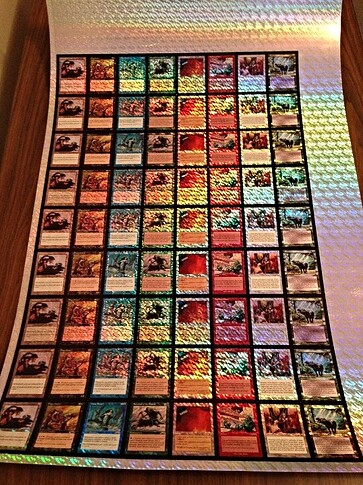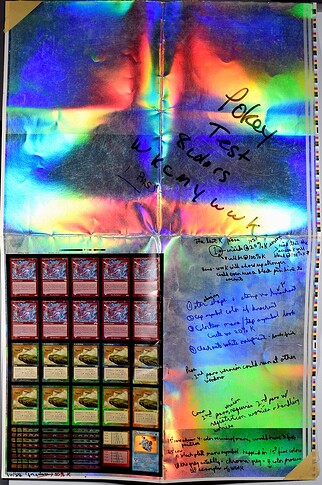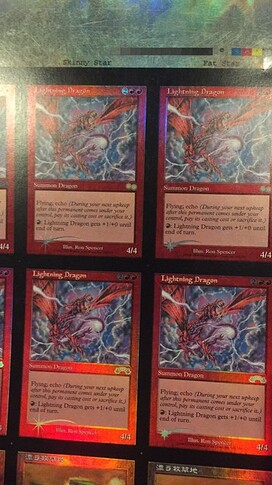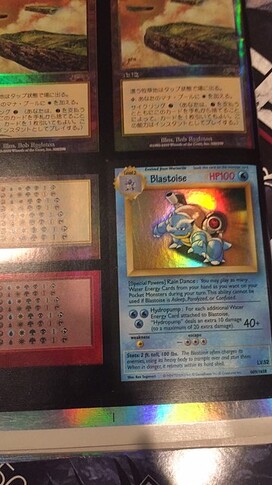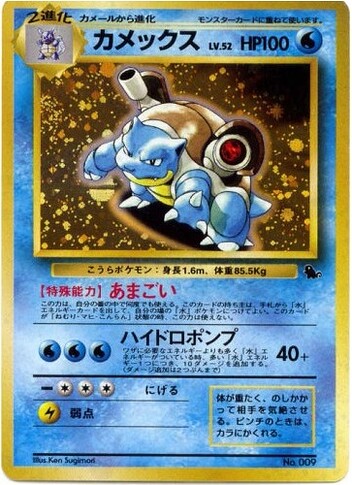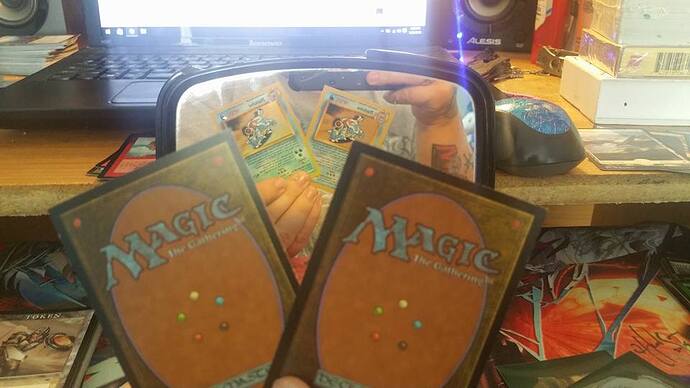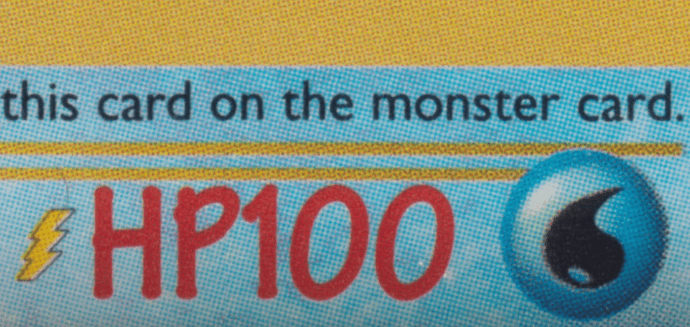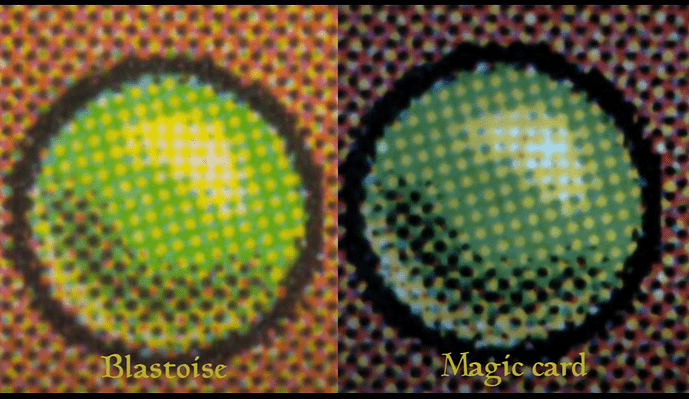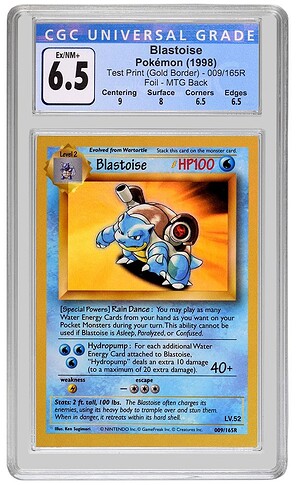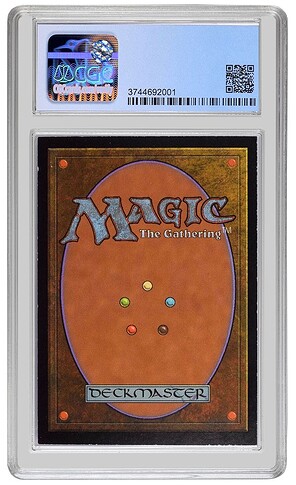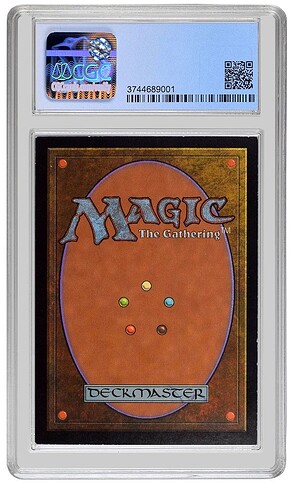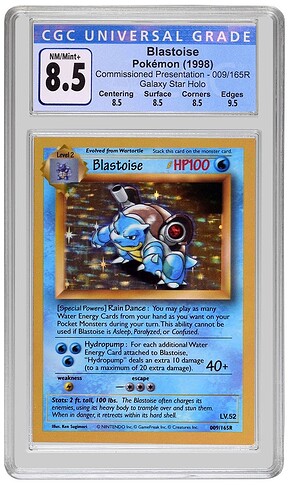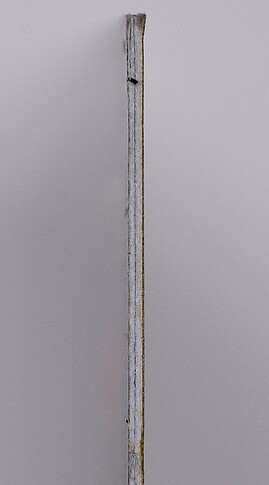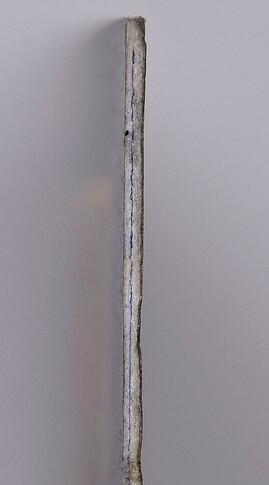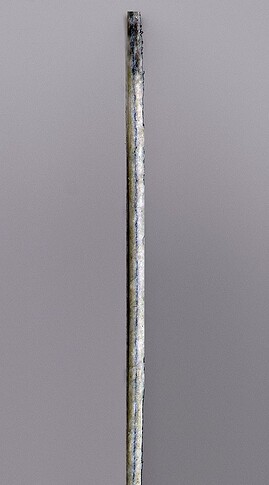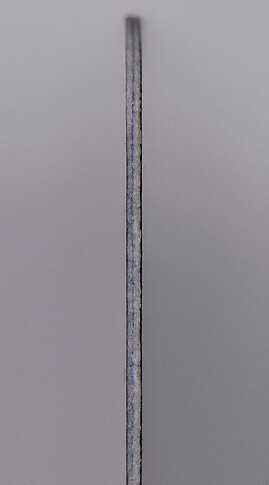A few days ago Tavis King, an expert in the Magic The Gathering community, posted his findings on the Prototype Blastoise. Due to that, I decided to use his videos as guide in creating this article, now that we have a better picture of its origin and finally the dot pattern prove we were waiting for.
This card has been in a lot of controversy in both the MTG and Pokémon communities. When it was first shown, the MTG community immediately believed it was real; the Pokémon community immediately believed it was fake. In this article I will go over its history as a timeline, and also include some opinions and relevant information of my own. I will also explain why the MTG and Pokémon communities had such an opposite believe regarding this card.
The Card
So, let’s start with a picture and a brief summary of the card, so we all know what we’re talking about here:


These cards are square cut; have a regular MTG back; and the front contains a Holofoil Blastoise in English, using the same artwork as the Japanese exclusive Blastoise that was available in both the Trade Please! campaign, which was later reprinted in the (also Japanese) Pokémon Song Best Collection CD. The front itself (text used; front used; artwork used; etc.) doesn’t look anything like any English Pokémon TCG card however, but more on that later.
Timeline:
Next, let’s go over the timeline:
Note by author: I never played nor collected MTG, so it’s likely some information regarding the MTG releases are inaccurate. I simply googled bits of information for this article.
Fall 1993:
Magic The Gathering, MTG for short, is a card game produced and released by Wizards of the Coast. The first MTG set came in the stores on August 5th, 1993 (source: Wikipedia), and by October 1993 they’ve already sold over 10 million cards (source). Although Wizards of the Coast (I’ll abbreviate it to WotC from hereon out) made multiple card games, MTG immediately became their number one success trading card game, and they were even reluctant to advertise it because they were afraid they couldn’t keep up with the existing demand.
October 1996:
On October 15th, 1996, the first two Japanese Pokémon cards (Glossy promos Pikachu and Jigglypuff) were released as inserts in the November 1996 CoroCoro Comic volume, and five days later on October 20th, 1996 the Japanese No Rarity Base Set (better known as “1st Starter & Expansion Pack” in Japanese) was released by Nintendo, which started the Pokémon TCG we all love to this day and age.
1997:
In 1997, WotC purchased the company TSR, who were responsible for the Dungeons and Dragons RPG board game. After that, WotC visited Japan for a meeting with their D&D and MTG distributers. At that meeting, they’ve heard that MTG was no longer the #1 TCG in Japan, and Pokémon was now the #1 selling TCG instead. Hearing this information, WotC was afraid that at one point, when Pokémon would inevitably be released in English, it might become a big competitor in the western market as well.
Fall 1997:
Possibly influenced by Pokémon, and maybe also to gain new interest among their consumers, MTG started doing test prints with foil cards. They’ve tried doing so in the past, but never went through with it. But near the end of 1997 they came back to this, and started doing foil test prints again. One foil test print they’ve made towards the end of 1997 was a Horned Turtle from the Tempest set. This test print was done in both English and Japanese.
February 10th, 1998:
The Japanese Trade Please! campaign ran from February 10th to July 31st, 1998. In this campaign, participants could mail a flyer that was included in the Let’s Trade Please CD of February 10th, 1998 to Media Factory (the company that at the time was responsible for the Pokémon anime and CDs) along with any two Pokémon TCG cards and a return envelope. Participants could also select a course on this flyer: A, B, or C. Media Factory would then send back one of Charizard, Blastoise, or Venusaur depending on the selected course respectively, as well as a Trade Please! promo card (fun fact: it’s one of just two Pokémon cards with a holofoil back, the other being -with six different versions- Ancient Mew). Here a picture of this Japanese Blastoise card, which has the same artwork as the Protostoise. Also note that it has a yellow lightning bolt as set symbol at the mid-right, which is next to the HP on the Protostoise.
1998:
Nintendo contacts WotC to ask if they wanted to become a partner, to produce and sell English Pokémon TCG cards in North America. Of course WotC gladly accepted this request, so Nintendo wouldn’t be a competitor and they can work on Pokémon together instead.
June 15th, 1998:
Not too relevant in general, but on June 15th, 1998 the Exodus MTG set was released, which we’ll talk about in the next section.
Summer 1998:
In the Summer of 1998 Wizards of the Coast continued doing test print runs to introduce holofoil cards into the MTG card game.
One of those test prints was an Exodus foil test sheet, since they already had the files of those cards being the last released MTG set, as mentioned one step above in the timeline. Below a picture of that test print to get an idea, although it’s not too relevant (source: Magic Librarrities). Some more info about these Exodus foil cards and sheet can be found in this March 16th, 2019 video of Tavis King.
Next we’ll discuss another uncut sheet, which was revealed in 2019 by a former WotC employee. This uncut sheet contained Traditional Chinese first Portal backs, and was printed by PBM Graphics, one of the printing facilities that WotC frequently used (this information can be found at the bottom of this uncut sheet).
For those unaware: when creating TCG cards, usually one company is responsible for the design and layout of the cards, which in this case was WotC; and another company is responsible for actually printing the cards, which were multiple companies spread across the world, depending on where the product would be distributed.
Here a picture of the back of that uncut sheet:
And here an additional picture of the back, which was posted in the CGC article mentioned at the December 7th, 2020 section below:
Unlike the back of the sheet which was fully printed, the front was mostly blank and only partially printed in the lower-left part. This front contained mostly holofoil MTG test prints. The top two rows contained English Lightning Dragon, which was the first Holofoil card released in the MTG card game (more on that in a bit). These Lightning Dragon test prints had a few different varieties for the purpose of this test print. The next two rows contained Japanese Drifting Meadow cards. And the final row contains a few ‘cards’ with just expansion, mana, and other symbols alike. And finally one card at the bottom right, which is the Blastoise test print.
Here a picture of the front of this uncut sheet:
And here the complete front, including blank parts, that was shown in the CGC article of December 7th, 2020:
And here two zoomed in pictures.
Note that the Protostoise is exactly the same as the yellow-bordered pictures at the very top of this article, with the only difference being the black borders. Apart from those borders, the cards are identical.
And again an additional zoomed picture of the Protostoise from the CGC article of December 7th, 2020:
We know this sheet was printed after the Exodus print run we’ve discussed earlier, but before the Lightning Dragon came out in September 1998.
Before these test prints, WotC had never produced any foil cards, so they were extensively testing things out. You have to keep in mind thing like ink density, ink opacity, and ink adhesion. Printing on a foil layer instead of regular cardboard layer is obviously different, and the ink sticks differently to the foil layer than a regular cardboard layer, and also bleeds outward differently. The key is to use a sufficient amount of ink to show up on the card, while at the same time still let the holofoil layer shine through at the parts you want it to. These test prints were done to ensure they had the correct settings and the cards would look as good as possible on the foil layers.
September 8th, 1998:
The Pokémon cartoons started appearing on US television (source: Wikipedia), and some other Pokémon merchandise, Gameboy games, and toys started appearing in stores. Some news was also given about the upcoming Pokémon TCG.
September 26th, 1998:
The MTG Urza’s Saga set was pre-released, with holofoil copies of the Lightning Dragon. The Urza’s Saga set itself (released on October 12th, 1998) didn’t contain any holofoil cards. Only the set after that (Urza’s Legacy of February 15th, 1999) contained holofoil MTG cards in the set itself. The Lightning Dragon card was the first holofoil MTG card however, released as part of the prerelease of Urza’s Saga near the end of September 1998.
Fall 1998:
After that WotC did more test prints for the Pokémon TCG. This includes the yellow-bordered test print Blastoise we’re talking about in this article; the Galaxy Holofoil we see in the English 1st edition Base Set Pokémon cards; and the Pokémon back. It’s likely the English Pokémon back wasn’t even (completely) designed yet when these Protostoise test prints were being created, which is another likely reason why they have the MTG backs. They were primarily testing holofoil cards for MTG, and the Protostoise was probably shown to their Japanese Pokémon colleague-company Nintendo, to ask verification if it’s what they were expecting. In the Fall of 1998, more changes to the design were done, until eventually the first Pokémon cards were released.
November 1998:
The December 1998 volume of Duelist Magazine, a magazine of WotC that mostly contains MTG releases, but also information about some of their other card games, was released in November of that year. This magazine mentioned that Pokémon booster packs would release in January 1999.
December 1998:
The Pokémon two player Demo pack was released, containing 24 Pokémon cards. This pack contained Shadowless cards (so no, not 1st edition!). Source: a video of someone opening one of these 1998 Demo Packs.
January 1999:
A few days/weeks before the first Pokémon Base Set would release in the USA (I don’t have an exact date), Trainer Deck A and Trainer Deck B decks were given to certain stores (although Trainer Deck B is definitely distributed a lot less than the Trainer Deck A - some more info about these decks can be found in this Efour thread). These decks were to promote the gameplay to kids, and were just like the Demo pack mentioned above never intended to be sold. We don’t know if they were issues randomly, to certain partners only, or upon request. We do know however, that their distribution was very brief. The cards in these decks had red bordered backs, with either a letter A or B:
January 1st, 1999:
The Japanese Pokémon Song Best Collection CD was released on January 1st, 1999, which contained reprints of earlier cards. For some cards we know ways to distinguish it from earlier releases, for other we don’t.
The English Shadowless Base Set yellow cheeks Pikachu in this set was for example printed on Japanese printing paper, which is slightly thinner than the printing paper used on English cards. If you shine through this CD promo Shadowless Pikachu yellow cheeks card as well as a regular English Shadowless Pikachu yellow cheeks card, you will clearly see the difference. The Pikachu from the CD is also slightly lighter in color.
Some of the other Glossy promos (Super Energy Retrieval; Computer Error; Mewtwo; and Mew) can be distinguished from their earlier Glossy releases by looking at the cross-section of the card, and the way the glossy plastic is facing (either upwards or downwards) (source).
The other six cards from the CD promo set (Venusaur; Charizard; Blastoise; Arcanine; Cool Porygon; and Hungry Snorlax), which are all non-Glossy, cannot be distinguished from their earlier prints as far as we know. The Blastoise in this CD promo set is therefore exactly the same as the one released for the Trade Please! campaign of February 1998, which we’ve mentioned earlier.
January 9th, 1999:
On January 9th, 1999, the English 1st edition Base Set was released in the USA. These 1st edition Base Set cards had thick stamps, although they later printed some additional Holofoil Rare sheets with thin stamps (more info about thick vs thin 1st edition stamps in this article). After the 1st edition cards ran out, they released a couple of Shadowless cards while they were busy updating the design. And then later when they finished this new design and made some text corrections, they printed unlimited ©1999 Base Set cards. People noticed the difference between the earlier Shadowless cards and these actual unlimited edition cards, so they started calling the previous print run without 1st edition stamps ‘Shadowless’. This ©1999 unlimited edition print run was done six more times. Later in 2000 they had one last and eighth print run of the Base Set, containing ©1999-2000 unlimited edition cards (as well as Vulpix with the HP error corrected). This ©1999-2000 unlimited edition print run was done in a factory in the UK, although most packs still contained ©1999 Holofoil cards in them. These ©1999-2000 cards were distributed within the UK, Poland, and Australia.
July 30th, 1999:
On July 30th, 1999 the Japanese Intro Pack was released, containing both a Bulbasaur and Squirtle Deck. The Squirtle Deck also contained a Blastoise with the same artwork as the earlier Trade Please! / CD promo. This version can be differentiated from the previous two by the set symbol at the right-hand side, as well as its lack of rarity symbol. This card was the final release of this artwork for the Pokémon TCG, and all three were exclusively released in Japanese.
September 2016:
Pictures of the two yellow-bordered Protostoise cards were shared in the #MTGRarities: Major Misprints, Test Prints, Oddities facebook group (although that FB group had a different name at the time). These were shared by James (note: I will use first names only in my article, to respect the privacy of those involved - all their names and contact information are available to the public however), who is pretty well-known within the MTG misprinted community, and has provided a lot of cool MTG test and misprints in the past. Almost all of those MTG test prints, as well as these Protostoise cards, came from the former WotC typesetter Chel. While he was a WotC employee he of course wasn’t allowed to sell any of the stuff, but when he was no longer an employee this was possible (although I assume WotC still wouldn’t be too happy either way). Chel saved a lot of interesting test print stuff for MTG over the years, as well as for Pokémon which he and his girlfriend collected. This mostly included a large number of regular promotional cards, but had a hidden gem in it every once in a while, like these Protostoise cards.
James had sold cards in the MTG misprinted group on behalf of this WotC typesetter in the past, so James was the go-to person whenever he wanted to sell stuff. Apparently James received a box mostly with Pokémon promo cards and some MTG stuff, but in it were two of these Blastoise cards, which he posted in the Facebook group in September 2016. At this time, the name of the WotC typesetter wasn’t know yet, since he obviously wanted to keep this to himself. (He later mentioned the name of Chel when more information about these Protostoise cards was necessary to be uncovered.) Here one additional picture that was shared alongside the two at the very top of this article:
September 27th, 2016:
Pictures of this Facebook post were shared here on the Efour forum. Here is that thread. As you can see in that thread, people immediately called it fake, and the thread was locked two days layer. (I personally had only joined the Efour forum a few weeks prior to that thread, so I can’t recall much from it personally, but at the time I thought it was a fake card as well.)
Here I’m going off-topic for a bit to explain why the opinions of the MTG and Pokémon communities were world’s apart for this card. As I mentioned earlier, I never collected MTG, so sorry if I say anything that’s incorrect.
Magic The Gathering: From what I’ve heard here and there, in the MTG community things like print numbers of sets were usually known; test prints popped up reasonably frequently; contact with WotC employees weren’t too uncommon; etc. Based on this, when a card like this came from a reliable source that had provided MTG test prints and misprints in the past, they believed it was real.
Pokémon: For Pokémon this is the complete opposite. Print numbers are almost never known; in the almost 25 years that the Pokémon TCG currently exists only NINE sample/test/prototype cards / card sets are known to exist (I’ll briefly go over them at the bottom of this article); and there isn’t any WotC employee to verify Pokémon related information at all.
Because of this, I can completely understand the reactions in that Efour thread of September 2016. The Pokémon card has a different font (always a huge indication of fake cards in Pokémon); the texts are completely different than released Pokémon cards (i.e. “escape” instead of “retreat costs”; lack of “resistance” column; “level” instead of “stage” above the Evolution box; etc.); the Blastoise artwork that was used was exclusively released in Japan; the Pokémon information at the bottom was different than the Base Set Blastoise. Given the limited information at the time (just those pictures, and that they were claimed to come from a former WotC employee), I most likely would have came to the same conclusion: it’s a very obvious fake similar as some of those Chinese fakes, not sure what they were even trying to accomplish with it. (At the time I had only just joined the forum a few weeks prior, so I was a complete novice when it came to Pokémon, and although I remember seeing pictures of it, I didn’t think much of it at the time.)
Here a few quotes from that thread as summary:
Obviously the people in the MTG community were disappointed that the Pokémon community reacted like this. Due to the opinions on our forum at the time, it was also not posted on the Magic Librarities Test prints page, nor allowed to be graded by BGS (who unlike PSA sometimes grades Pokémon test prints, like the For Position Only cards or MATCHPRINT cards) - although I doubt BGS would have graded these cards even if the Efour forum would have been more positive to be completely honest…
Again, for the MTG people reading this: you must understand that the history and knowledge of the MTG and Pokémon communities are completely different in terms of test prints, print numbers, WotC contacts, or just information available in general.
April 2018:
The owner of the two Protostoise cards gave one of the cards to one of the vendors at an MTG convention called Benjamin, to see if they can provide any more evidence.
Summer 2019:
A third Protostoise was found in a storage box of a closed down game store. This game store was frequented by WotC employees and artists in the past, since it was nearby the WotC headquarters. One of the owners of this store also modeled for a MTG artwork.
The person who found this card posted about it on the MTG Facebook group, as well as the Efour forum. (And later also provided close-up scans to Tavis King, but more on that later.)
Someone within the Pokémon community also came into contact with another WotC employee. But apart from confirming it was a real test print, no further information was given. Pretty useless in general, but I mention it because it’s relevant for the next part:
A few months later the owner of the third Protostoise card got into contact with this same WotC employee, and they meet in person. At this time, the Efour thread below was already created and discussions were in full swing. This was when the pictures of the uncut sheet were posted in the Efour thread and also on Facebook, which I mentioned below in one of the quotes (see the October 1st, 2019 section).
June 16th, 2019:
The owner of this third Protostoise card posted another thread on the Efour forum. (Note: the owner of the post later on deleted some of his comments in the thread including the first, so if the thread looks incomplete you’re not mistaken…) This time a lot more information was known, and a lot of MTG experts were willing to stake their reputations on it being a legit print run after closely examination the card over the past few years.
Obviously there were still a lot of people within the Pokémon community that thought it was fake, which is a reasonable assumption since some of those people saw this card for the first time. But, given the better arguments than back in September 2016, it wasn’t locked as fast as before. This time we eventually saw pictures of the uncut sheet. We had constructive arguments why it could be a real test print or whether it’s still fake; mixed in with some people who just kept calling it fake, and the person who posted it who primarily wanted to sell it in addition to providing information, and who was getting angrier and angrier towards the people calling it fake in the Efour thread.
One thing that most of the people in that thread kept asking for were close-up images of the dot pattern of the front and back of the card, including the L-shaped red dots in the green orb of the MTG back, which unfortunately wasn’t provided at the time. Here a few quotes from the thread as a summary (wall of text incoming, but I figured it was necessary - I also advice to look at the thread itself to get a better picture of what was being discussed, including all of the smaller comments - some trolling; some going off-topic; and some just reacting to others):
As well as some MTG cards with Pokémon backs on an uncut sheet:
[/quote]
Note from author: this above was one of my comments, and I now realize that those lines are indeed due to the scanner.
This video above is where Tavis King unboxes the card, that was sent to him for verification. After this, some of us were eagerly awaiting his findings, but the thread was long locked and partially forgotten before we got that response two days ago (and which was the trigger for me to write this article).
C Nitz - He was the typesetter for Pokémon. Made the way the cards look, and copy/pasted the text from files over to the card. He told me he actually developed the method for them to automatically transition the text of each card onto the graphical design of the cards, which is partially why he was very upset when he was eventually let go. He told me he made their original physical copy / past process go from 2 week long for a 300 card magic set, to only 2 hours. Based on what he told me, and what I already shared, he had a direct part in the way Pokémon cards looked from WotC.
He actually really disliked Pokémon as an IP, he started working at Wizards because he wanted to help make Magic, he thought they were each their own piece of art, and didn’t really care about making cards for a children’s cartoon show with weird animals. Paraphrasing there. I understand his sentiment, I unfortunately was a young teenager when it came to America, and I loved it, but the are direction back then wasn’t what it eventually became, and he wanted to be an artist, and help make art.
[/quote]
At this point, the OP owner posted it on the Virbank FB group to sell, so the Efour thread went off-topic because of that and was locked on October 3rd, 2019:
December 4th, 2020:
On December 4th, 2010, a couple of days ago at time of writing, we finally had a video from Tavis King regarding this card, including the close-ups we’ve been waiting for to confirm the dot pattern.
Some of the information above, especially about the MTG releases, also came from his videos as source.
Tavis King posted seven videos in total about this card, and I will give a short summary of each of them below:
Mail Day 7: Blastoise Test Print Part 1 Pokémon & MTG:
Summary of this video:
Box opening of three packages. One are some regular paper printouts from the WotC office; one is the second copy of the Protostoise; and one contains German test prints that came from the same WotC employee source as these Protostoise (more info about those cards in this thread - I’m still not sure what to believe on these, but it was interesting to hear they have the same source as the first two Protostoise cards and a lot of other MTG test prints).
Blastoise Test Print Part 2: Where Did They Come From? Pokémon & MTG:
Summary of this video:
Two of these Protostoise cards were first posted in September 2016 in the Misprint & Oddities MTG Facebook group. This post was deleted due to accusations at the time, including the first Efour thread mentioned above.
The owner got them through an ex WotC employee, who had provided cool MTG WotC stuff in the past. After a few years of silence, they came back in 2016 to start selling MTG oddities again.
This WotC employee was a typesetter (someone who designs the cards), and he and his girlfriend were into collecting Pokémon at the time, so he kept some cool Pokémon stuff, that he wanted to sell in 2016 after he was no longer a WotC employee. This WotC employee gave a box of stuff to ‘James’ to sell on the MTG Facebook group, as was done before. In that box were these two Blastoise test printed cards.
Blastoise Test Print Part 3: Concerns Pokémon & MTG:
Summary of this video:
Explanation how WotC cards were designed and printed. The layout and design of the cards is done by typesetters of WotC, and the printing is done elsewhere (depending on where it is going to be released). WotC employees therefore can’t print legit cards like they are being printed at their printing facilities; and those facilities can’t print anything else than the designs that WotC provides them. Both parties are necessary to print a card that will be released.
Blastoise Test Print Part 4: Other Cool Stuff From The Same Source Pokémon & MTG:
Summary of this video:
In this video Tavis goes over a few other MTG test prints, including:
- mini MTG cards that were made by WotC employees for fun (and printed at a local smaller printing facility);
- printouts on paper
- Test GodBook, a printout on paper of the pictures of the cards printed by WotC themselves. They use this for their archive for each MTG set, and sometimes also use it for stock magazine images and such
And finally Tavis goes over all kind of different test prints, of which most came from this same WotC employee that provided these Protostoise cards.
Blastoise Test Print 5: Addressing The Accusations Pokémon & MTG:
Summary of this video:
Tavis mentions the original Efour thread of September 2016, and how it was immediately discarded as a fake card. He also mentions it wasn’t added to the MTG Librarities website because of that, nor accepted for grading by BGS. In this video he basically provides counter-arguments for the comments mentioned in that thread. I won’t go over each of them, but some examples include:
- The messages in the Facebook conversation had a different front: some Samsung apps change the Facebook Messenger font
- No previous sales before this copy popped up: they were still looking into the legitimacy of this card, and the asking price might also have been too high
- The font is Comic Sans: not true (see 19:50 in the video above)
And Tavis also shows some different Pokémon print runs, and how the design and layout has changed over the years (he compares a Fossil set Moltres with a Fates Collide Moltres for example, and he also shows some other Pokémon cards with a different design, like a Full Art Mewtwo EX).
Blastoise Test Print Part 6: Authentication Pokémon & MTG:
Summary of this video:
This is the main event we’ve been waiting for. This video of more than an hour shows close-ups of the dot pattern of the Blastoise, and comparisons to other cards.
Tavis first explains how it can’t be a re-backed card:
- No raw material to create such a re-backed card
- No glue residue to support this on the Protostoise, which can be seen in an example re-backed card he shows
- Re-backed cards are usually slightly smaller
- It has square corners instead of rounded ones
He then shows a scan of the side of the card so we can see the black graphite layer, and how it’s the sandwich we’re used to with Pokémon (and MTG) cards. He also explains the purpose of the graphite layer:
- Keeping both cardboard parts together (obviously)
- Blocking light going through the card as much as possible
- When we gently bent the card, the graphite layer causes the card to snap back into its original shape
- The color of the graphite layer isn’t too important, and there have been different colors of graphite layers in MTG sets, like red, yellow, blue, etc. (it’s black / dark grey on this Protostoise card)
He does a light test on the Protostoise, which doesn’t let light go through like a real Pokémon card.
He shows close-ups of fake MTG cards as examples:
- One real MTG card which has been stripped of its colored front, and reprinted on with an ink jet printed - clearly fake
- One that was printed on a laser jet printed - fuzzy, colors on the black/white parts, different colors in general
- One that was printed on an off-set printing press (which is also used for real cards) - still similar as the previous, and also Rosetta pattern printing on the white MTG borders
After that Tavis gave some more information of things we already discussed above, like how a third copy has popped up and was shared on the Efour forum. And how the other former WotC employee was contacted and pictures of the uncut sheet with the black-bordered Protostoise were shared.
After Tavis King opened the card back in July 25, 2019, he took the card to the Misprint Com Columbus, a convention of high-end MTG collectors. There a lot of MTG experts looked at the card up close; compared it to other MTG released cards; compared it to some Pokémon cards; compared it to MTG test prints and the miniature cards the WotC employees made for fun; etc.
Their conclusion: it was a real test print.
Tavis then explains about the uncut sheet, which I mentioned above at the Summer 1998 section.
From 30:47 onward, Tavis shows a close-up of the Blastoise front and back so we can (finally) clearly see the Rosetta pattern. He also shows comparisons to a real MTG back so we can verify the L-shaped red dots in the green orb. And he also shows some comparisons to the other orbs, and some of the letters at the back.
Here some screenshots from the video:
Ignore the color shade differences. Not only is this normal for different print runs (there are a lot of of different shades of Base Set cards), but it’s also because one was a saved scan and the other a live scan.
The important part: the dot and Rosetta patterns match, and we can see the four red dots in the L-shape on the white section of the green orb, which is present on all real MTG card backs.
After that Tavis compares it to some other cards, like the card WotC printed themselves on a laser printer (so the Protostoise is indeed a test print, and not something WotC employees made for fun); a fake MTG card (so the Protostoise is a real test print); etc.
He also compares it to the Japanese CD promo Blastoise (picture from the internet instead of scan made by himself), as well as a regular (English ©1999 unlimited edition) Blastoise Holofoil Rare card.
And finally a comparison of all three Protostoise cards with one another.
Blastoise Test Print Part 7: The Story
Summary of this video:
In this video Tavis gives a summary himself, rather similar as this timeline in this article.
At the very end he also mentions he plans on making more videos regarding printing numbers of this Protostoise card, as well as an in-depth look at the information of the uncut sheet that contained the black-bordered Protostoise.
Update: December 7th, 2020:
Just yet CGC posted an article about these Blastoise test prints themselves, and also announced that they’ve graded four of these cards, including the three mentioned above. Since their article contains some additional information, I’ve edited my article were applicable with pictures from their article, and will also add some information here.
Let me start with a picture of all four of the CGC-graded Protostoise cards:
The first two are the ones that were first shown on the MTG Misprint Facebook group by James in September 2016. The third is the copy found in the storage unit of the old game store, and was shared in July 2019.
And the fourth is from a later test print, owned by a former WotC employee since it has been printed. This card doesn’t have a back at all, and features the Galaxy Holofoil we’re used to for actually released Base Set Holofoil Rares. This card was used in a single interview to show what English Pokémon cards could look like, although documentation of that interview has been lost over time. Apparently another similar example was used for international use, but its current whereabouts are unknown.
CGC also provided additional scans, pictures, and experiments, which I will share here as well:
Scans of the sides of the card, so we can see the graphite inner layers. The top three from left to right: the first two Protostoise from September 2016; and the third from July 2019. The bottom three from left to right: the fourth with Galaxy holofoil mentioned above; the one from the uncut sheet; and the picture shows a regular MTG card from that era as comparison.
CGC also provided close-up pictures of the Rosetta pattern of the entire back, and a close-up of the green plus yellow orbs, but since those are already covered above I won’t add them here. They can be found in the article.
The fourth Protostoise with Galaxy holofoil and white back has also been compared with a released English Base Set Holofoil Rare. Here a side-by-side of this Galaxy holofoil Protostoise on the left and a released Base Set Magneton on the right:
In addition to that, CGC uses the latest technology for additional verifications:
- Compare Spot-Fluorescent lighting. (quote) “This type of imaging uses different wavelengths of high intensity light to show how the inks used react to the light source on the infrared spectrum. Different inks will, of course, not react in the same way as they are made up of different elements. However, in this case, all of the cards look essentially the same on the infrared spectrum. Note how HP100 and the cannon are both lit up on all of the cards, and the background gradient responds similarly as well. The only minor difference is Card D (refering to the Galaxy holofoil test print), which shows a slightly darker art box. This makes perfect sense, however, as it is the only example produced using a different foil. All of this is strong evidence that the inks used are the same across every card. Nevertheless, CGC Trading Cards took the examination a step further and looked at the card backs once again, but this time under UV light. While there is some minor variation in the hues on the back, likely due to different positioning relative to the UV light source, all of the elements still react with similar effect under UV light. This demonstrates once again that the inks used are the same.”
- X-ray fluorescence (XRF) scanner. (quote) “XRF uses X-rays to non-destructively excite the atoms of a sample and then measure the secondary X-rays omitted by the sample. This allows for the elemental composition of the sample to be quantified. The XRF scanner showed that the same elements were utilized in the inks of all five cards. Based on the graph above, the blue ink appears to be made up primarily of Titanium (Ti), Iron (Fe), Copper (Cu) and Zinc (Zn). There are some slight differences amongst the cards, but all are within tolerance and there is clearly a pattern. If any of the inks were different, the line would follow a completely different path.”
Thanks to CGC’s research, we now have additional prove these are indeed test prints, as we’ve concluded yesterday when I wrote this article based on Tavis King’s videos. I will also quote the conclusion CGC made in their article:
As I mentioned earlier, I will also briefly go over ALL nine Pokémon test prints that are known to exist at one point in time (which is now ten, with the addition of this Protostoise card). (Note: the list below is in no particular order.)
-
English E3 Expo of May 2001. Pictures of a Pichu and Dratini card with unique artwork are known, but it’s unknown whether any made it into public hands or all were destroyed after the events. The Pichu has the word SAMPLE in red at the right-hand side in the artwork.
-
English E3 Expo of May 2002. Four card booster packs were given to visitors, containing the 58/165 Pichu, 112/165 Hoppip, a Manhole card, and a Kirby card. These cards are also in English and have a new Japanese back, and don’t have the world Sample mentioned anywhere.
-
The 58/165 Pichu, 112/165 Hoppip, and Manhole card were also available as so-called ‘Manhole promos’. I’m not sure how and when these were distributed, but I’ve heard they were given at kiosks of game stores to demonstrate the new e-Reader devices. These have the English front, as well as English back, and there are two different versions: one set of three which are glossy (like the Japanese Glossy promos from vending machines or CoroCoro magazines) just on the front; and one set of three which are glossy at both the front AND the back. Both versions also have a pretty large hole at the top. Here a picture of all three of these cards from my personal collection.
-
Ten English Sample set cards were given at the New York Press Conference of August 2002. These cards were created by MEDIAFACTORY in Japan instead of Wizards of the Coast, even though they are English as well. The ten cards in this set are: 002/093 Hoppip; 004/093 Koffing; 016/093 Pikachu (this one I own myself, so here a scan); 019/093 Gastly; 048/093 Chansey; 074/093 Rapidash; and 083/093 Pichu. These also have the new Japanese back, and all contain the world SAMPLE in black at the front. The e-reader codes also contain an “M”-prefix instead of “B”-prefix. It is not known how many copies were leaked to the public, but this is probably the most well-known Sample set for the Pokémon TCG.
-
Three Japanese cards, Pikachu, Pichu, and Eevee, were shown at the Press Conference in Tokyo, on March 7, 2001. An unknown amount were leaked to the public. These test prints have two different e-Reader borders. Here a picture of all three of them: Pikachu; Pichu; Eevee. These pictures came from an auction of 2016 on Yahoo Japan (the domestic Japanese eBay).
-
In August 2001 at the Nintendo Space World even in Chiba, new Sample cards were shown. These cards again had the word SAMPLE on them, and they also contained a hole. Just like the ones mentioned at #1, it is unknown if they were all destroyed or any have survived. The ones for which (vague) pictures are available are: Caterpie; Oddish; Wartortle; Psyduck; Pikachu (here a better picture); Pichu; Abra; Spearow; a second Spearow; Clefairy; and Dratini (the Dratini has the same artwork as the English Dratini shown at #1).
-
In that same auction of 2016 mentioned at #5, some other Japanese Sample cards were sold. These came from various Japanese sets, like Team Rocket; Neo Genesis; Jungle; etc. Here a picture of all those Sample cards from the auction. As you can see, they have a double border with e-reader dot-codes, and also contain a number on the top of the artworks.
-
English MATCHPRINT cards. These English cards are square cut, and have a white back with the words “DIGITAL HALFTONE - IMATION MATCHPRINT - COMMERCIAL BASE” diagonally across it. Here is a video of TCA Gaming, where he shows all the Matchprint cards that were leaked from the WotC factory, which he owned at one point. In this video he explains how many copies exist of each, which is just two copies from most cards, and four copies for some of the Trainer and Energy cards near the end. These cards were used for testing colors. I personally own one of the two existing Pikachu cards, so here again a scan of it.
-
There are a couple of cards with the words “FOR POSITION ONLY” on top of them. Here a complete guide for these. These test prints include an 33/165 Alakazam; 34/165 Ampharos; 35/165 Arbok; 36/165 Blastoise; 39/165 Charizard; 41/165 Clefable; 44/165 Dugtrio; and a very rare Manhole card with that same FOR POSITION ONLY stamp. They also have Medium in the bottom-left corners, and on the Charizard the “HP” is missing after the “100”. They were found in Legendary Collection booster packs.
Some additional source about these Sample cards:
*And there you have it. We now finally have close-up pictures of this Protostoise and comparisons to real MTG cards. Based on this evidence, I can only come to the same conclusions as the MTG experts: it’s a real test print, made by WotC prior to the release of the English Pokémon TCG.
It’s unfortunate it took so many years before we finally have this full picture with all the information above (especially the close-up pictures), but it was interesting to gain knowledge about this card over time.
Disclaimer: I don’t own this card, nor would I want to own it personally given its advertisement prices. I’m just someone who loves to learn new information about the Pokémon TCG I love, and am a fan of unofficial and Sample cards like these, and the history behind it. I also don’t make any claims about what something like this is worth, that’s something for the sellers and buyers to discuss for themselves and is irrelevant for the purpose of this article. I’m simply sharing information which primarily has been accumulated by the MTG experts over the years, so almost all credit of this article goes to them, and Tavis King with his latest videos especially.*
Greetz,
Quuador (Kevin)
